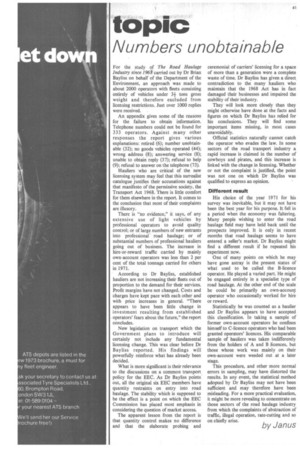topic
Page 43

If you've noticed an error in this article please click here to report it so we can fix it.
Numbers unobtainable
For the study of The Road Haulage Industry since 1968 carried out by Dr Brian Bayliss on behalf of the Department of the Environment, an approach was made to about 2000 operators with fleets consisting entirely of vehicles under 3+ tons gross weight and therefore excluded from licensing restrictions. Just over 1000 replies were received.
An appendix gives some of the reasons for the failure to obtain information. Telephone numbers could not be found for 333 operators. Against many other responses the report gives various explanations: retired (6); number unobtainable (32); no goods vehicles operated (44); wrong address (8); answering service (8); unable to obtain reply (37); refusal to help (9); refusal to answer on the telephone (73).
Hauliers who are critical of the new licensing system may feel that this surrealist catalogue justifies their accusations against that manifesto of the permissive society, the Transport Act 1968. There is little comfort for them elsewhere in the report. It comes to the conclusion that most of their complaints are illusory.
There is "no evidence," it says, of any extensive use of light vehicles by professional operators to avoid quality control; or of large numbers of new entrants into professional road haulage; or of substantial numbers of professional hauliers going out of business. The increase in hire-or-reward traffic carried by mainly own-account operators was less than 2 per cent of the total tonnage carried for others in 1971.
According to Dr Bayliss, established hauliers are not increasing their fleets out of proportion to the demand for their services. Profit margins have not changed. Costs and charges have kept pace with each other and with price increases in general. "There appears to have been little change in investment resulting from established • operators' fears about the future," the report concludes.
New legislation on transport which the Government plans to introduce will certainly not include any fundamental licensing change. This was clear before Dr Bayliss reported. His findings will powerfully reinforce what has already been decided.
What is more significant is their relevance to the discussions on a common transport policy for the EEC. As Dr Bayliss points out, all the original six EEC members have quantity restraints on entry into road haulage. The stability which is supposed to be the effect is a point on which the EEC Commission has placed most emphasis in considering the question of market access.
The apparent lesson from the report is that quantity control makes no difference and that the elaborate probing and ceremonial of carriers' licensing for a space of more than a generation were a complete waste of time. Dr Bayliss has given a direct contradiction to the many hauliers who maintain that the 1968 Act has in fact damaged their businesses and impaired the stability of their industry.
They will look more closely than they might otherwise have done at the facts and figures on which Dr Bayliss has relied for his conclusions. They will find some important items missing, in most cases unavoidably.
Official statistics naturally cannot catch the operator who evades the law. In some sectors of the road transport industry a rapid increase is claimed in the number of cowboys and pirates, and this increase is linked with the change in licensing. Whether or not the complaint is justified, the point was not one on which Dr Bayliss was qualified to express an opinion.
Different result
His choice of the year 1971 for his survey was inevitable, but it may not have been the best year for his purpose. It fell in a period when the economy was faltering. Many people wishing to enter the road haulage field may have held back until the prospects improved. It is only in recent months that road haulage seems to have entered a seller's market. Dr Bayliss might find a different result if he repeated his experiment now.
One of many points on which he may have gone astray is the present status of what used to be called the B-licence operator. He played a varied part. He might be engaged entirely in a specialist type of road haulage. At the other end of the scale he could be primarily an own-account operator who occasionally worked for hire or reward.
Statistically he was counted as a haulier and Dr Bayliss appears to have accepted this classification. In taking a sample of former own-account operators he confines himself to C-licence operators who had been granted operators' licences. His comparable sample of hauliers was taken indifferently from the holders of A and B licences, but those whose work was mainly on their own-account were weeded out at a later stage.
This procedure, and other more normal errors in sampling, may have distorted the results. In any event, the statistical method adopted by Dr Bayliss may not have been sufficient and may therefore have been misleading. For a more practical evaluation, it might be more revealing to concentrate on those sectors of the road haulage industry from which the complaints of abstraction of traffic, illegal operation, rate-cutting and so
on chiefly arise. by Janus
























































































































































